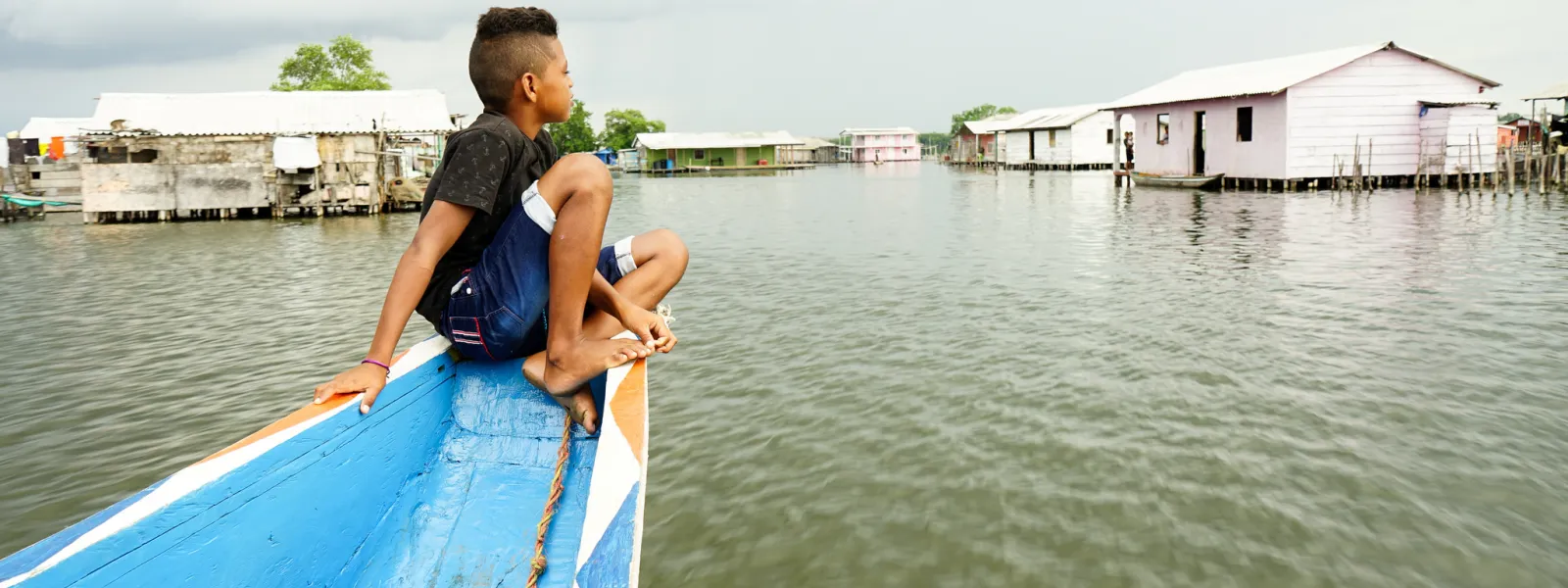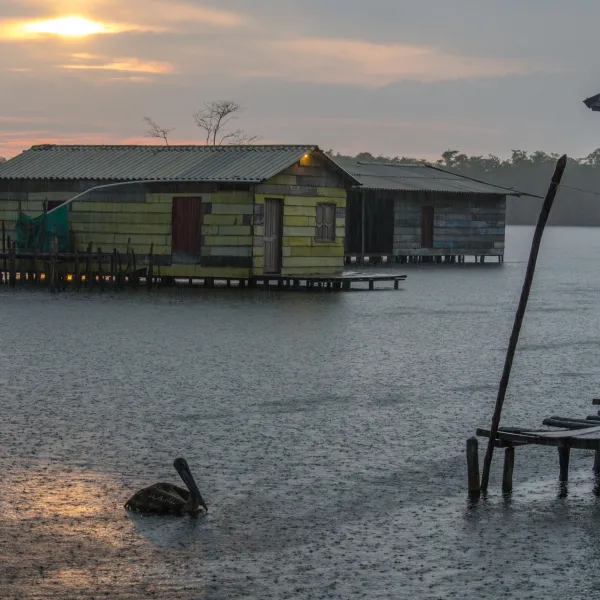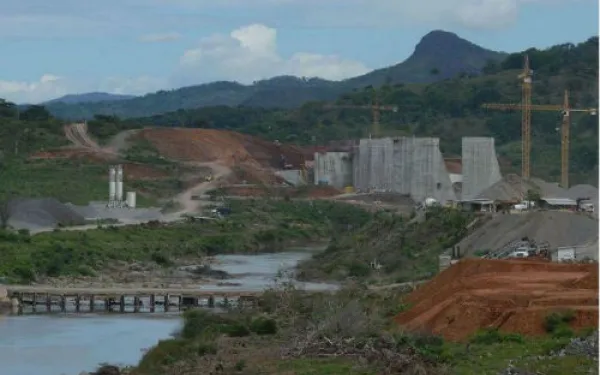
Project
Photo: Anna Laurie Miller / AIDAConserving the Ciénaga Grande de Santa Marta
Ciénaga Grande de Santa Marta, the largest and most productive coastal wetland in Colombia, covers 45,000 hectares. At the confluence of the Magdalena River and the Caribbean Sea, the site boasts an immense variety of flora and fauna, including mammals, birds and fish. Its southern tip is a beautiful sanctuary of mangroves, swamp and amphibious forest.
On the calm waters of the marsh stand the Ciénaga’s famous stilt villages, supported by pillars or simple wooden stakes and inhabited by local fishermen since 1800. In a place accessible only by water, many of the things we take for granted—being served a glass of water, quick access to a doctor—are considered luxuries. Residents depend on the natural world around them. Sadly, in recent years mass fish die-offs caused by the marsh’s degradation have threatened the livelihoods of 2,500 people who call the Ciénaga Grande home.
Illegal activities are destroying this vital ecosystem: intentionally set forest fires, deforestation of large tracks of land for agriculture and livestock, logging and burning of mangroves, and 27 kilometers of illegally built dikes.
This destruction not only devastates the local fishery; it also has global impact. Ciénaga Grande’s mangroves absorb large quantities of carbon dioxide from the atmosphere, aiding in the global fight against climate change.
The importance of the Ciénaga Grande has been recognized both nationally – the Sanctuary of Flora and Fauna Ciénaga Grande de Santa Marta is a national park – and internationally: UNESCO’s Man and the Biosphere program declared the lagoon a biosphere reserve; and the Ciénaga Grande is listed as a Wetland of International Importance under the Ramsar Convention, an intergovernmental treaty for the protection of wetlands.
AIDA and our partners are advocating for the Colombian government to fulfill its national and international obligations to protect the Ciénaga Grande. After all, millions of animals, the local community, and our global climate depend on it.
Partners:

Related projects
Páramos: Defending Water in Colombia
Colombia’s páramos occupy just 1.7 percent of the national territory, yet they produce 85 percent of its drinking water. These rich sources of life are threatened by activities like large-scale mining, and their protection should be a point of national interest. So just how does the magic happen? The páramos are high altitude wetlands. Despite being located in the equatorial zone, they remain cool throughout the year, which enables their soils to maintain rich volcanic nutrients. All these characteristics make the páramos true sponges that capture moisture from the atmosphere, purify water and regulate its flow. The growth of the economy, the production of electricity and life itself are all made possible by the water provided by Colombia’s páramos: Bogota’s water comes from the páramos of Sumpaz, Chingaza (at risk) and Cruz Verde (at risk from mining exploration). The water in Medellin arrives from the páramo of Belmira. The Santurbán páramo (at risk from gold mining projects) supplies water to Bucaramanga. In Cali, the Farallones are vital springs of water. Life in all these cities depends on the páramos. That’s why AIDA is committed to the protection of these valuable ecosystems. It’s about defending our sources of fresh water, our right to live. This fight recently called us to: Call the World Bank’s attention to the risks of its investment in the Angostura mine, in the Santurbán páramo, which would harm both people and the environment. Co-organize a seminar about páramos and mining at the Universidad Sergio Arboleda in order to discuss and understand the latest legal and technical regulations on the subject. We Are Not Alone Social movements in defense of water, life and páramos have blossomed across the country. The Committee for the Defense of Water and the Santurbán Páramo and the Committee for Cruz Verde are two strong examples. Greenpeace Colombia has also promoted the end of mining in the Pisba páramo in Boyacá. Meanwhile, after many extensions, the Environmental Minister announced last December the delimitation of the Santurbán páramo. However, he also announced that mining projects that already had a title and an environmental license would be permitted to continue. The Canadian mining company Eco Oro then issued a public statement that, even with the delimitation of Santurbán, it would continue developing the Angostura mine on a smaller scale. This delimitation opens the way for similar actions on which the recognition and protection of other Colombian páramos will depend. As members of civil society we must remain vigilant so that such actions comply with national and international environmental and human rights standards. Our water, and therefore our life, is at risk. Where will our fresh water come from in 2015, when our numbers are millions more? If we don’t protect our páramos today, Colombia’s future generations will be deprived of access to water. Current problems in Lima, Peru and São Paulo, Brazil remind us that this reality might not be too far away.
Read morePáramos: Defending Water in Colombia
Colombia’s páramos occupy just 1.7 percent of the national territory, yet they produce 85 percent of its drinking water. These rich sources of life are threatened by activities like large-scale mining, and their protection should be a point of national interest. So just how does the magic happen? The páramos are high altitude wetlands. Despite being located in the equatorial zone, they remain cool throughout the year, which enables their soils to maintain rich volcanic nutrients. All these characteristics make the páramos true sponges that capture moisture from the atmosphere, purify water and regulate its flow. The growth of the economy, the production of electricity and life itself are all made possible by the water provided by Colombia’s páramos: Bogota’s water comes from the páramos of Sumpaz, Chingaza (at risk) and Cruz Verde (at risk from mining exploration). The water in Medellin arrives from the páramo of Belmira. The Santurbán páramo (at risk from gold mining projects) supplies water to Bucaramanga. In Cali, the Farallones are vital springs of water. Life in all these cities depends on the páramos. That’s why AIDA is committed to the protection of these valuable ecosystems. It’s about defending our sources of fresh water, our right to live. This fight recently called us to: Call the World Bank’s attention to the risks of its investment in the Angostura mine, in the Santurbán páramo, which would harm both people and the environment. Co-organize a seminar about páramos and mining at the Universidad Sergio Arboleda in order to discuss and understand the latest legal and technical regulations on the subject. We Are Not Alone Social movements in defense of water, life and páramos have blossomed across the country. The Committee for the Defense of Water and the Santurbán Páramo and the Committee for Cruz Verde are two strong examples. Greenpeace Colombia has also promoted the end of mining in the Pisba páramo in Boyacá. Meanwhile, after many extensions, the Environmental Minister announced last December the delimitation of the Santurbán páramo. However, he also announced that mining projects that already had a title and an environmental license would be permitted to continue. The Canadian mining company Eco Oro then issued a public statement that, even with the delimitation of Santurbán, it would continue developing the Angostura mine on a smaller scale. This delimitation opens the way for similar actions on which the recognition and protection of other Colombian páramos will depend. As members of civil society we must remain vigilant so that such actions comply with national and international environmental and human rights standards. Our water, and therefore our life, is at risk. Where will our fresh water come from in 2015, when our numbers are millions more? If we don’t protect our páramos today, Colombia’s future generations will be deprived of access to water. Current problems in Lima, Peru and São Paulo, Brazil remind us that this reality might not be too far away.
Read more
Four Recommendations for the Summit of the Americas
Inequality has increased in the last decades in Latin America, and this clearly is an obstacle for democracy. Latin America remains the region with the greatest income inequality on the planet. Considering this, the Organization of American States has made "Prosperity with Equity" the theme of its upcoming Summit of the Americas. In Panama on April 10 and 11, Heads of State and Government will pledge concerted actions at both the national and regional levels to confront the development challenges of the continent. I believe that the main goal should be to just stop doing certain things, or, at least, to act differently. When I asked Eli, an indigenous Ngobe from Panama, what she wanted from her government, she said, "Just that they leave us alone." Drawing on OAS consultations with civil society, AIDA analyzed two of the eight Mandates for Action, the document to be negotiated at the Summit. From this analysis, we have made the following recommendations relating to the mandates on energy and the environment: 1. Stop building large dams The Mandates establish that the region will join the United Nations Initiative, Sustainable Energy for All (SE4ALL). Since access to energy plays a key role in reducing inequality, we recommend working with this initiative provided hydroelectric dams are excluded from sustainable energy. Among other harms, Dams produce greenhouse gases, aggravating climate change, especially in tropical regions. Dams cause irreparable harms to the environment and human rights violations. Dams typically cost twice as much as their developers’ estimates, even without considering their socio-environmental damages. In addition, constructing these energy dinosaurs takes much more time than expected. Three currently suspended dams prove the point: Belo Monte (Brazil) - Suspended after protests of affected communities whose compensation had been breached. It is a year late, and the project is facing fines and the possible payment of additional interest on loans from Brazil’s national development bank, BNDES. El Quimbo (Colombia) - The filling of the dam is suspended by judicial order for lack of an evaluation of its impact on the fishing sector. Barro Blanco (Panama) - Suspended by an order of the government while they revise—and hopefully fix—irregularities in the Environmental Impact Assessment. From all this, we remind the Summit of the Americas that last December more than 200 organizations, networks, and movements from across the world requested that governments, international organizations, and financial institutions realize that large dams are an unsustainable source of energy and implement truly sustainable solutions. 2. Recognize the human rights impact from climate change Climate change has caused and will continue to cause serious impacts in Latin America that are compromising the enjoyment of human rights. Climate change is a priority on the Summit’s agenda, which is good. But government leaders should incorporate an understanding of the relationship between climate change and human rights. They should commit to respect human rights in all climate actions. The United Nations and the OAS General Assembly have recognized that the respect for and enjoyment of human rights are intrinsically connected to climate change. The World Bank has concluded that climate change complicates efforts to end poverty, which has clear implications on human rights. Even the recent draft of the negotiating text of the United Nations Framework Convention on Climate Change contemplates the necessity to respect human rights. For all these reasons, the Summit should consider that the link between climate change and human rights must be incorporated into all actions seeking to combat inequality and promote better standards of living. 3. Include a commitment to mitigate climate change, not just adapt to it The Summit’s Mandates for Action refer to adaptation measures. But mitigation should not be left out. These actions would reflect the reality of the region, in which important efforts are being developed to confront climate change. Considering the principle of common but differentiated responsibilities, all States must demonstrate willingness to implement mitigation actions to confront climate change. Although not all States should mitigate to the same extent, all countries should contribute to this task—including those in Latin America. 4. Recognize that corruption undermines equity, and include actions to eradicate it The Mandates for Action recognize the impacts of corruption in as much as the use of technology is intended to improve public participation. But corruption is a structural problem in the region and actions to confront it should be part of democratic governance. Corruption has a direct relationship with inequality, systematically preventing real progress in the fight against poverty.
Read more